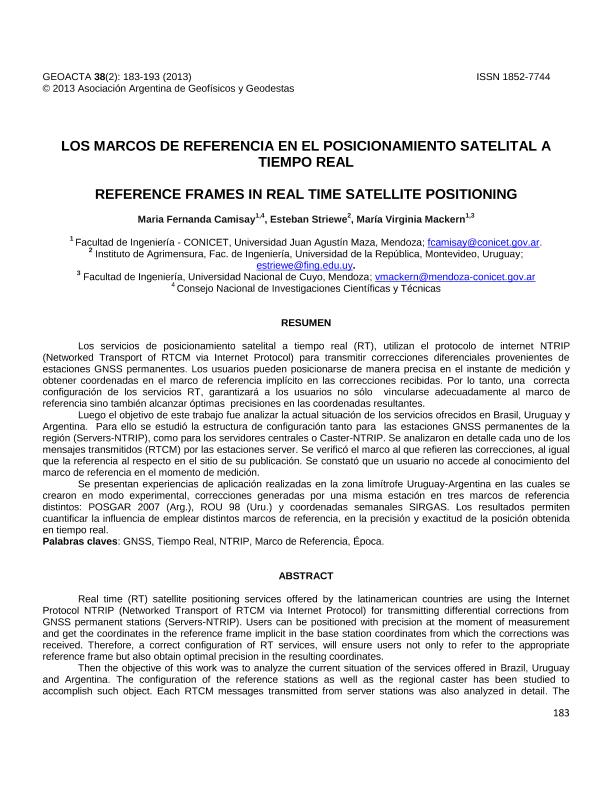Mostrar el registro sencillo del ítem
dc.contributor.author
Camisay, Maria Fernanda

dc.contributor.author
Striewe Dieste, Esteban

dc.contributor.author
Mackern Oberti, María Virginia

dc.date.available
2016-12-26T14:25:45Z
dc.date.issued
2013-12
dc.identifier.citation
Camisay, Maria Fernanda; Striewe Dieste, Esteban; Mackern Oberti, María Virginia; Los marcos de referencia en el posicionamiento satelital a tiempo real; Asociación Argentina de Geofísicos y Geodestas; GEOACTA; 38; 2; 12-2013; 183-193
dc.identifier.issn
1852-7744
dc.identifier.uri
http://hdl.handle.net/11336/10072
dc.description.abstract
Los servicios de posicionamiento satelital a tiempo real (RT), utilizan el protocolo de internet NTRIP (Networked Transport of RTCM via Internet Protocol) para transmitir correcciones diferenciales provenientes de estaciones GNSS permanentes. Los usuarios pueden posicionarse de manera precisa en el instante de medición y obtener coordenadas en el marco de referencia implícito en las correcciones recibidas. Por lo tanto, una correcta configuración de los servicios RT, garantizará a los usuarios no sólo vincularse adecuadamente al marco de referencia sino también alcanzar óptimas precisiones en las coordenadas resultantes. Luego el objetivo de este trabajo fue analizar la actual situación de los servicios ofrecidos en Brasil, Uruguay y Argentina. Para ello se estudió la estructura de configuración tanto para las estaciones GNSS permanentes de la región (Servers-NTRIP), como para los servidores centrales o Caster-NTRIP. Se analizaron en detalle cada uno de los mensajes transmitidos (RTCM) por las estaciones server. Se verificó el marco al que refieren las correcciones, al igual que la referencia al respecto en el sitio de su publicación. Se constató que un usuario no accede al conocimiento del marco de referencia en el momento de medición. Se presentan experiencias de aplicación realizadas en la zona limítrofe Uruguay-Argentina en las cuales se crearon en modo experimental, correcciones generadas por una misma estación en tres marcos de referencia distintos: PORGAR 2007 (Arg.), ROU 98 (Uru.) y coordenadas semanales SIRGAS. Los resultados permiten cuantificar la influencia de emplear distintos marcos de referencia, en la precisión y exactitud de la posición obtenida en tiempo real.
dc.description.abstract
Real time (RT) satellite positioning services offered by the latinamerican countries are using the Internet Protocol NTRIP (Networked Transport of RTCM via Internet Protocol) for transmitting differential corrections from GNSS permanent stations (Servers-NTRIP). Users can be positioned with precision at the moment of measurement and get the coordinates in the reference frame implicit in the base station coordinates from which the corrections was received. Therefore, a correct configuration of RT services, will ensure users not only to refer to the appropriate reference frame but also obtain optimal precision in the resulting coordinates.
Then the objective of this work was to analyze the current situation of the services offered in Brazil, Uruguay and Argentina. The configuration of the reference stations as well as the regional caster has been studied to accomplish such object. Each RTCM messages transmitted from server stations was also analyzed in detail. The reference frames of the coordinates were verified, as well as the reference to it in the publishing site. It was found that a user does not have information of the framework at the time of measurement.
Results of experiences performed in the Uruguay - Argentina border zone were presented. Experimental streams was created from the same station on three different reference frames: POSGAR 2007 (Arg) , ROU 98 (Uru.) and weekly SIRGAS coordinates. These results quantify the influence of using different reference frames in the accuracy of the real time positioning.
dc.format
application/pdf
dc.language.iso
spa
dc.publisher
Asociación Argentina de Geofísicos y Geodestas
dc.rights
info:eu-repo/semantics/openAccess
dc.rights.uri
https://creativecommons.org/licenses/by-nc-sa/2.5/ar/
dc.subject
Ntrip
dc.subject
Rtk
dc.subject
Posicionamiento a Tiempo Real
dc.subject
Gps
dc.subject
Gnss
dc.subject
Tiempo Real
dc.subject
Marco de Referencia
dc.subject
Epoca
dc.subject
Real Time
dc.subject
Reference Frame
dc.subject
Epoch
dc.subject.classification
Geociencias multidisciplinaria

dc.subject.classification
Ciencias de la Tierra y relacionadas con el Medio Ambiente

dc.subject.classification
CIENCIAS NATURALES Y EXACTAS

dc.title
Los marcos de referencia en el posicionamiento satelital a tiempo real
dc.title
Reference frames in real time satellite positioning
dc.type
info:eu-repo/semantics/article
dc.type
info:ar-repo/semantics/artículo
dc.type
info:eu-repo/semantics/publishedVersion
dc.date.updated
2016-09-12T16:50:17Z
dc.journal.volume
38
dc.journal.number
2
dc.journal.pagination
183-193
dc.journal.pais
Argentina

dc.journal.ciudad
Bahia Blanca
dc.description.fil
Fil: Camisay, Maria Fernanda. Consejo Nacional de Investigaciones Científicas y Técnicas. Centro Científico Tecnológico Mendoza; Argentina. Universidad Juan Agustín Maza. Facultad de Ingeniería; Argentina
dc.description.fil
Fil: Striewe Dieste, Esteban. Universidad de la República. Facultad de Ingeniería; Uruguay
dc.description.fil
Fil: Mackern Oberti, María Virginia. Consejo Nacional de Investigaciones Científicas y Técnicas. Centro Científico Tecnológico Mendoza; Argentina. Universidad Nacional de Cuyo. Facultad de Ingenieria; Argentina
dc.journal.title
GEOACTA
dc.relation.alternativeid
info:eu-repo/semantics/altIdentifier/url/http://ppct.caicyt.gov.ar/index.php/geoacta/article/view/3595
dc.relation.alternativeid
info:eu-repo/semantics/altIdentifier/url/http://ref.scielo.org/58d7kh
Archivos asociados
